Periodicals
Periodicals

École nationale supérieure des beaux-arts de Lyon
Initiales #05 — Andrea Fraser
Claire Moulène, Emmanuel Tibloux
Le cinquième numéro de la revue d'art et de recherche « rétro-prospective » est consacré à l'artiste et performeuse Andrea Fraser, figure clé de l'art des années 1990 et 2000 et du courant de la « critique institutionnelle » (une monographie complétée par une grande enquête sur l'espace critique réalisée auprès d'une cinquantaine d'artistes, critiques et philosophes internationaux).
Avec contributions de Kader Attia, Eva Barto, Sophie Bonnet-Pourpet, Marie de Brugerolle, Gregory Buchert, Daniel Buren, Marie Canet, Gregory Castéra, Inès Champey, Thierry Chancogne, Claire Fontaine, François Cusset, Judith Deschamps, Paul Devautour, Philippe Durand, Joao Enxuto & Erica Love, Andrea Fraser, Nicolas Frespech, Dora García, Romain Grateau, Emmanuel Guez, Thomas Hirschhorn, Aliocha Imhoff & Kantuta Quirós, Béatrice Josse, Franck Larcade, Ju Huyn Lee, Sven Lütticken, Fabrice Mabime, Bartomeu Mari, Chus Martínez, Gwenael Morin, Claire Moulène, Jean-Luc Moulène, Yan Moulier Boutang, Vincent Normand, François Pain, Gerald Petit, Anne Querrien, Thierry Raspail, Sinziana Ravini, Delphine Reist & Laurent Faulon, Christophe de Rohan Chabot, Phillippe Roux, Jean-Baptiste Sauvage, Thomas Schlesser, Ida Soulard, Fabien Steichen, Michel Surya, Emmanuel Tibloux, Vier 5, Ulf Wuggenig, Italo Zuffi.

Worms #7 'Artists who Write and Writers who Art'
The ‘Artists who Write and Writers who Art’ Issue. For Worms 7 we’ve looked to our visual counterparts for some soil nutrients. We’ve wormed our way into the psyche of the artist, to bring you the ‘Artists That Write, and Writers That Art’ issue. Many of our subjects in the past have come into writing via non-traditional routes (filmmaking, curation, art, performance, podcasting, and so on), so it only felt right to cast a spotlight over those who have inspired our experimental literary practices so far. Not only those that use words within their visual practice, but those who use images to inform their writing. The reader, the writer, the artist, the activist, the poet and performer; they’re all here and they’re all worms.
In this mega worm (which is fittingly pink, for the first time somehow) you are in for a feast. Clem interview Helen Marten, Martine Syms and Diamond Stingily, Caitlin interviews actual art-writing icon Olivia Laing, Pierce talks to the profound Dr. Joy James, Philippa Snow gives us her thoughts on the act of writing art criticism (spoiler: it’s out her ass), and we have enough Derek Jarman content to keep you going for the rest of the year. We have some hilarious/insightful/weird/wonderful contributions from some of your favourite regulars too; including Jess Cole, Isabelle Bucklow, Sam Moore, Haydée Touitou, Estelle Hoy and many others.
(Note from the publisher)
FEATURING:
DIAMOND STINGILY, HELEN MARTEN, NICOLE RUDICK, NIKI DE SAINT PHALLE, MARTINE SYMS, OLIVIA LAING, DR. JOY JAMES, JORDAN WEITZMAN, WU TSANG, DEREK JARMAN, SABINE MIRLESSE, MISHA HONCHARENKO, CHANTAL AKERMAN, JOANNA NOVAK, ANNIE ERNAUX, DAISY SANCHEZ, JENNA SUTELA, ANICKA YI, TUOMAS A. LAITINEN, STEPHANIE COMILANG & SIMON SPEISER, VALERIE SOLANAS
CONTRIBUTORS:
HAYDEÉ TOUITOU, L SCULLY & LUCAS RESTIVO, LEE RAE WALSH, JESS COLE, ESTELLE HOY, PHILIPPA SNOW, SAMANTHA ROSENWALD, ISABELLE BUCKLOW, MONA GLASSFIELD, CLEM MACLEOD, SARAH WHITE, CAITLIN MCLOUGHLIN, PAVIELLE GARCIA, IONE SAIZAR, CHANTAL JOFFE, SOPHIE DAVIDSON, PIERCE ELDRIDGE, VIOLET CONROY, ELLE PÉREZ, PAUL MPAGI SEPUYA, JACQUELINE ENNIS-COLE, MARY ADETURINMO, STEPH FRANCIS-SHANAHAN, SAM MOORE, BUG SHEPHERD-BARRON, DONNA MARCUS DUKE, SAM HOLTON BRADLEY, KITTY GRADY, FELIX PILGRIM, CICI PENG, HOLLY MILLS, THEA MCLACHLAN, ERICA GOULD, PAULA DUCAY AND INÉS GARCÍA, ELVIRA GARCIA, INÊS GERALDES CARDOSO, JODIE HILL, JEMIMA SKALA, MAURA SAPPILO, DELIA RAINEY

Fieldnotes: Issue 4
The fourth issue of FIELDNOTES contains new work by:
Adeola Titiloye, ajw, Fanny Howe, Will Alexander, Michael O’Mahony, Agnieszka Szczotka, Renee Gladman & Isabel Mallet, Can Xue, Karen Gernant & Chen Zeping, Tony Brooks, Nwuguru Chidiebere Sullivan, Mat Jenner, Alba Schloessingk, Camille Roy, Pete Segall, Johanna Hedva, Beihua Guo, Cedar Sigo, KP Culver
FIELDNOTES is an artist-run publishing project based in Newham in east London, aiming to promote and support non-conforming creative practices that pioneer new cultural forms.

Spike #75 – Closed due to Colonialism, Elitism, and a Private Dinner – The Museum Issue
Spike #75 fêtes the museum in all its stuffy, messy, showy, old-timey glory, as a home-away-from-home, the address of solace and astonishment.
Featuring William Pope.L, Simon Wu, Louise Lawler, Ben Davis, Ann Demeester, Anthony Hudek, Meschac Gaba, Bernadette Van-Huy, Ghislaine Leung, Estelle Hoy, Tea Hacic-Vlahovic, and many more.
This issue is a guestbook to be leafed through at half-light, to be reminded among all the petitions to should of what the museum already is: a trove of our symbols and the histories they shift for; a stubborn beauty mark amid everything's turning smoother; an agora and a target and a legacy of timeless becoming. If it is a half-light of dawn, let it be a new chapter; and if dusk, then a eulogy of many voices.
Founded by the artist Rita Vitorelli in 2004, Spike (Spike Art Quarterly) is a quarterly magazine on contemporary art published in English which aims at sustaining a vigorous, independent, and meaningful art criticism. At the heart of each issue are feature essays by leading critics and curators on artists making work that plays a significant role in current debates. Situated between art theory and practice and ranging far beyond its editorial base in Vienna and Berlin, Spike is both rigorously academic and stylishly essayistic. Spike's renowned pool of contributing writers, artists, collectors and gallerists observe and reflect on contemporary art and analyse international developments in contemporary culture, offering its readers both intimacy and immediacy through an unusually open editorial approach that is not afraid of controversy and provocation.
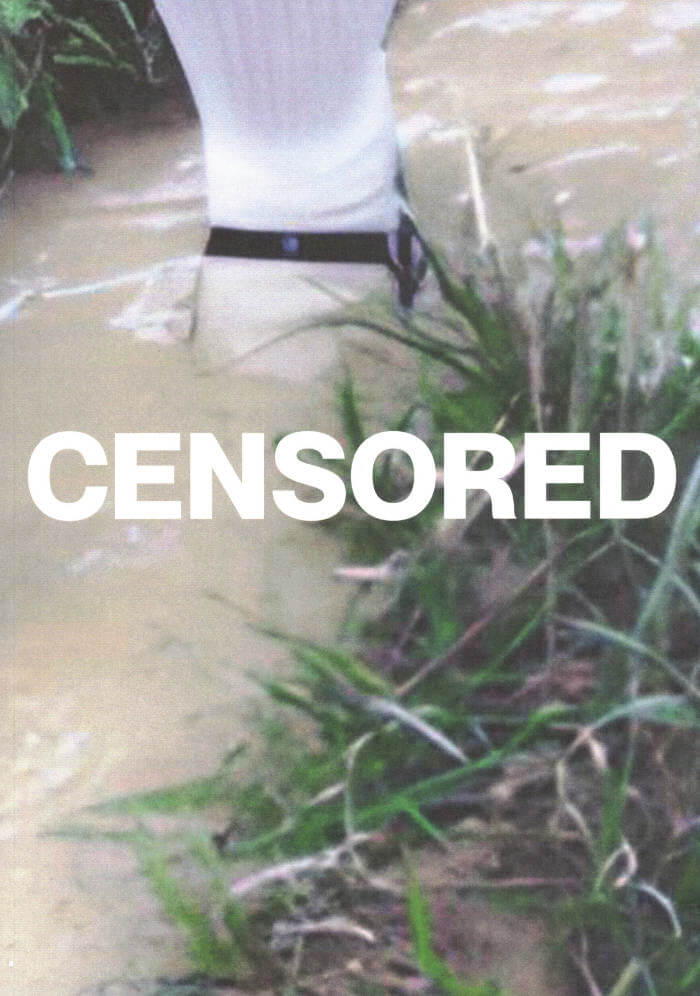
Apocalypticotrashecocidocious - Censored 08
« Apocalypticotrashecocidocious », l’édition Censored 08, parle d’écologie et de luttes anticapitalistes, de vivant et d’humilité
Ses recherches, textes et productions artistiques mènent à une conclusion : l’urgente nécessité de faire front commun pour quitter les logiques d’exploitation hyperviolentes envers la terre, les espèces, les femmes, minorités de genre et personnes racisées. Politiser le rapport que nous entretenons à nos territoires mutilés, qu’ils soient urbains ou ruraux. Comprendre comment le capitalisme s’est érigé en culte quasi religieux fondé sur la dépossession des savoirs, le déracinement des émotions, l’anti-spiritualité et l’individualisme. Il est alors question de militances joyeuses et du refus de la fatalité, de relations inter-espèces, de spiritualités noires, d’écologie au quotidien, de culture white trash et de futurs possibles.
Comment penser l’écologie lorsque c’est notre propre mode d’existence qui parasite le vivant ? Qu’apprendre des mammifères marins ou des espèces invertébrées ? Quels arts, récits et spiritualités pour aller au-delà des imaginaires dystopiques féministes et engendrer l’action ? Comment s’organiser collectivement tout en apprenant à rester à sa place et sans hiérarchiser ?

F.R. David - Zeros And Ones
G. Leung, W. Holder and 2 more
Riffing off the title, this volume includes an interview with Carolyn Lazard – an artist whose conceptual and often spare videos, sculptures, installations, and performances explore the full amplitude of relation – by Catherine Damman, plus a feature on New York-based contemporary artist Tishan Hsu, whose practice examines the “embodiment of technology”, and contributions by time-based media artist Silvia Kolbowski, for whom political resistance, the unconscious, and structures of spectatorship are a central concern of all her projects; choreographer and dancer Yvonne Rainer; and science fiction author Octavia Butler.
Retroactively compiled from the curators*’ footnotes to the exhibition handout of the 2021 exhibition Zeros and Ones, at KW Berlin.
Dedicated to the Sadie Plant book of the same name (Zeros + ones: digital women + the new techno culture, 1997), the issue embodies a (cybernetic) reading & writing machine, as it co-authors artists’ work.
* Edited with Kathrin Benthele, Anna Gritz, and Ghislaine Leung - the edition has 180 pages, 4 colour plates, two bookmarks, an otherwise unavailable postcard donated by the Stanley Brouwn estate, and… SIXTEEN possible covers, reproducing a work by Lutz Bacher.

Girls Like Us #14 - Letters of Disappointment
Marnie Slater, Katja Mater and 2 more
Considered an ‘ugly feeling’ by society’s norm, we’re not supposed to vocalize what and who is letting us down. We’re supposed to stay positive, get organized and act, instead of lingering in negative emotions. We’re supposed to be productive. But making space for disappointment can be a strategy of dissensus. Instead of wallowing in impotence, to make explicit what is not meeting expectations for this world can be an act of renouncing and making cracks in the status quo, while not giving up allegiance that another world is possible.
In Living a Feminist Life, Sara Ahmed writes: ‘we might think of how becoming feminist put us in touch with all that sadness, all those emotions that represent a collective failure to be accommodated to a system as the condition of possibility for living another way.’
In this issue we hope to plant the seeds of this rebellion by collecting a larger body of letters of disappointment. No matter how vague, impersonal, unimportant, futile, banal, or contingent these memories may seem; when shared and brought into a wider collective context, political desire may slip out from between the lines and build a corpus of transfeminist inheritance.
While spending some time with a tarot deck in preparation for this issue we obviously pulled the card of disappointment. In this deck, the illustration shows a beautiful drought: five crystal cups, which in the other cards overflow with fresh water, are shown here empty and dry.
‘The Five of Cups stands for an emotional crisis. It might be that unconscious fears come true, it could tell that feelings are disrupted or wasting away, the soul is empty and unfulfilled. In the sequence of the cups, the Five is the logical consequence of the Four. The grey tristesse that was lurking behind the luxury’s glamour is now exposed, the ‘truth is out’. The Five of Cups implies the loss of illusion, the realization of a deception. It hurts, but is necessary when we don’t want to spend the rest of our lives with our heads in the sand.’
We leave it up to you to imagine the possibilities or boundaries of what spending time with disappointment can make happen, for you, in your community, in the world.
Contributors: Pelumi Adejumo, Clara Balaguer, Dagmar Bosma, Staci Bu Shea, Alba Clevenger, Athena Farrokhzad, Sharona Franklin, Maike Hemmers, Calla Henkel, Sara Kaaman, Alena Kolesnikova, Maoyi (Peixuan Qiu), Katja Mater, Yelena Moskovich, Djuwa Mroivili, Sands Murray-Wassink, Raoni Muzho, Iarlaith Ni Fheorais, Ashley Nkechi Igwe, Milica Trakilović, Shola von Reinhold, Selma Selmani, Terre Thaemlitz, Yin Yin Wong, Anna Zvyagintseva, Sophie Zwertbroek, Joanna Walsh, Rosa Luxemburg, Yoyes Maria Dolores Gonzalez Katarain, Clara Zetkin, Alexandra Kollontai and Audre Lorde

Girls Like Us #5 - Play
Marnie Slater, Katja Mater and 2 more
In a world with too many choices and too little time to explore, play is an excellent strategy. Objects, roles, bodies, settings – anything can be transformed in play. Playing across time, space, architecture, beds, houses, lives, papers. Suddenly a chair is a plane is a stroy is an animal is an avatar is a new reality. Making up worlds, filming them. Surfing warm and cold waves. Playing with identities. Playing en masse. Playing to be free.
A digital conversation with performance artist boychild, writer Chris Kraus on beer brewing and BDSM, music producer and artist Fatima Al Qadiri on her 1989 haircut, Californian surfers by Eve Fowler & Mariah Garnett, curator Annick Kleizen recapturing the artist residency circuit from a hammock in Brazil, artist Jesse Darling paraphrasing Drake, musicians The Knife dissecting their communal experiment ‘Shaking The Habitual’ through the eyes of their collaborators.
Featuring Boychild, Chris Kraus, Wu Tsang, Jesse Darling, Fatima Al Qadiri, Jam Rostron, Marit Östberg, Hanne Lippard, Kapwani Kiwange, Maroussia Rebecq, Kenji Minogue, Mariah Garnett, Eve Fowler, Lily van der Stokker, Rachel de Joode, Mademoiselle Yulia, Katja Mater, Sarah Forbes Keough, Annick Klezine, Emily Roysdon, Analisa Teachwroth, Jess Arndt, Martin Falck, Laura Davis, Mandy Pernell, Amy Sillman and Jesper Strombäch Eklund.

Girls Like Us #9 - Dance and dancing
Marnie Slater, Katja Mater and 2 more
DANCE AND DANCING explores the New York dance scene – past, present and future. It’s our first ever guest-edited issue compiled by New York based writer and artist Emma Hedditch.
Featuring: Mariana Valencia, Cynthia Oliver, Marlies Yearby, Laurie Carlos, Chrysa Parkinson, devynn emory, the skeleton architecture, Discwoman, Svetlana Kitto, Jonah Groeneboer, Dona Ann McAdams, Lydia Okrent, Kim Brandt, kara lynch, Effie Bowen, Mary Manning, Res, Leah Gilliam, Amelia Bande, Luciana Achugar, Emily Wexler, Ayo Janeen Jackson, Suzan D. Polat, Mina Nishimura, Ursula Eagly, Emmakate Geisdorf, Angie Pittman, Lerato Khathi, Yvonne Meier and Aunts.
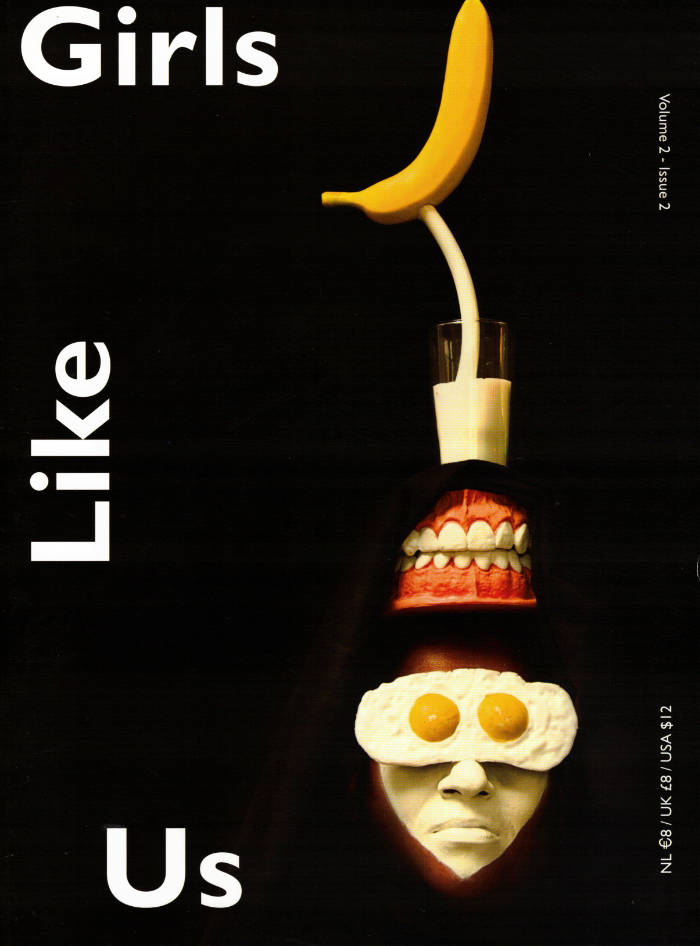
Girls Like Us #2 — Issue 2
Marnie Slater, Katja Mater and 2 more
The second issue of the Amsterdam lesbian arts quarterly with newly appointed co-editor Vela Arbutina at the helm.
Features include Vava Dudu and Theo Mercier, Tavi Gevinson and Diane Pernet, Keren Cytter and Dafna Maimon, Lauren Flax and Lauren Dillard, Kaisa Lassinaro, Matthew Lutz-Kinoy, Leilah Weinraub, Benjamin A. Huseby, Eline McGeorge, Janis Pönisch, Anie Stanley, Andrea Ferrer, Devrim Bayar.
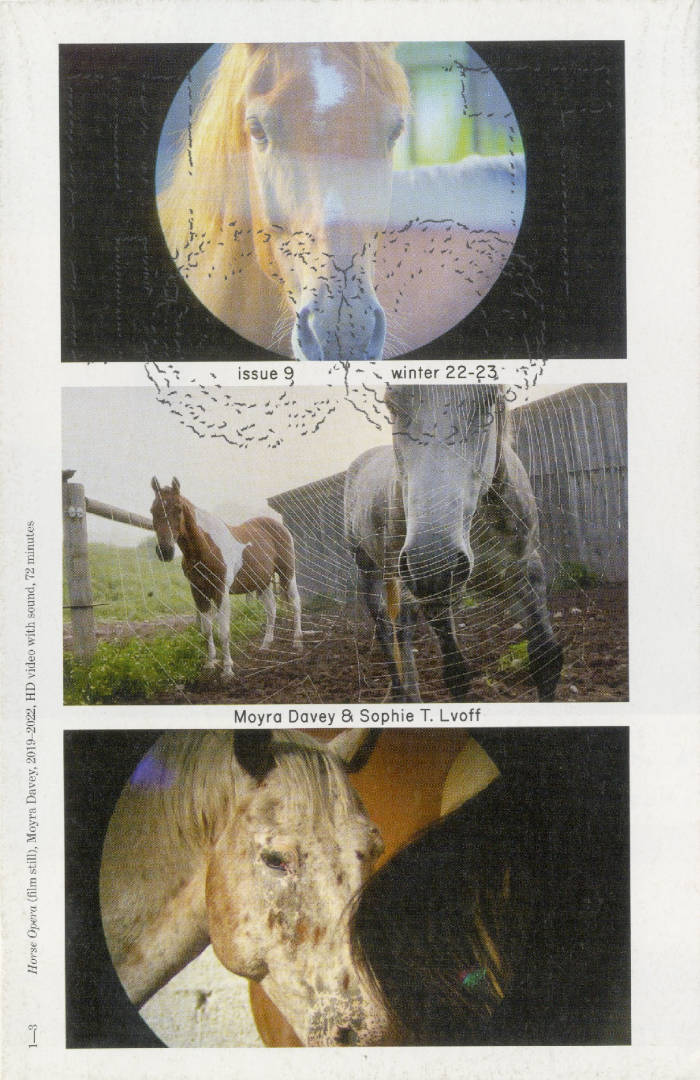
HOOT nr. 9 — Moyra Davey & Sophie T. Lvoff
The 9th HOOT pops up for the winter 2022-23, but the conception of this issue started well over a year ago at our beloved Plage Avant (Traduttore, traditore’s studio, Marseille).
We met Sophie T. Lvoff at many openings and art related events in Marseille these last few years, having a practice that appears mainly as photography, Gufo got curious about all the processes that she uses which involve sound, installation, writing… and more. She welcomed us in her studio of the city of Marseille where she recently settled.
We found out about the “trompe-l’œil” of this iconic checkered table, witnessed the installations of translucid and colored objects evolving on the sunny wall, and looked through her photographic chamber it’s called a large-format camera, but this is funny… For this issue, Sophie suggested to interview another artist, Moyra Davey, who also works in photography and writing, and appeared to have shared experiences too.
The topics of everyday life, intimacy that images embody in both their works, take another dimension as soon as their thoughts, voices and writing expand and express the entirety of their gestures.
This issue is the first interview between two native English-speaking artists, who have ties to the French language from childhood.
The penpals are the main characters of that encounter where we are very welcome to join in their very generous conversations. This is only an excerpt of a long and well referenced correspondence.

BRAIDS
Natalia Irena Nikoniuk, Gabriela Galeao Batres
BRAIDS is a 130 pages-long publication that features both visual and written works of 20 young creatives. The desire of BRAIDS is to expand the idea of queerness beyond the borders of identity. The journal exists to host bodies that deny framing and dare to expose the vulnerability of their difference. The publication is thus a woven story of the contemporary globalised queer, insecure but daring, honey-glazed yet continuously aching.

DAISYWORLD MAGAZINE #5
DANGEROUS DEPTHS
DAISYWORLD MAGAZINE is an independent art publication questioning antrhopocentrism.
Contributions by:
Zazie Stevens (ed.) with Heleen Blanken, Brackish, Fiona Glen, Carolin Gieszner, X Arias, Annika Kappner, Eszter Koncz, Hattie Morrison, Maria Naidich, Michaela Spiegel, Jenna Sutela, Timaeus, Stef Veldhuis, Hedwich Rooks, Hannah Rose Whittle

Revue Phylactere n°2 - Oh là là !
Roxanne Maillet, Auriane Preud'homme
Phylactère est une revue annuelle à voix multiples, née du désir d’explorer l’écriture de l’oralité et les possibilités de retranscription de performance, à travers des visions authentiques, subjectives et spontanées. Donnant la parole à des amateur·ice·s, artiste·s, designer·s et penseur·se·s, la revue Phylactère regroupe des écrits de transition, assumant tous les glissements entre un script, l’action réalisée et sa traduction, avec une attention extrême et aventureuse pour la manière dont les contextes, gestes, émotions et espaces sont mis en jeu lors de cette retranscription.
Initiée par Roxanne Maillet et Auriane Preud’homme à l’invitation de Camille Videcoq lors de la résidence Entrée Principale (Marseille), Phylactère conjugue pratique graphique et éditoriale et démarche curatoriale en intégrant au processus de publication l’organisation de différents événements.
Pour son deuxième numéro, Phylactère prend pour titre l’onomatopée Oh là là !
Avec les contributions de : Anne Lise Le Gac, Benoît Le Boulicaut, Camille Videcoq, Cecil Serres, Claudia Pagès, Considered to be Allies (Margaux Parillaud & Mie Frederikke Fischer Christensen), Ghita Skali, Giuliana Zefferi, Lauren Tortil, Loreto Martínez Troncoso, Louise Hervé & Clovis Maillet, Mona Gérardin-Laverge, Nygel Panasco, pauline l. boulba, Sarah Browne, Susie Green (with Kim Coleman, Simon Bayliss & Rory Pilgrim), Tahnee, L’autre and Tiziana La Melia.
Conception graphique : Auriane Preud'homme et Roxanne Maillet.
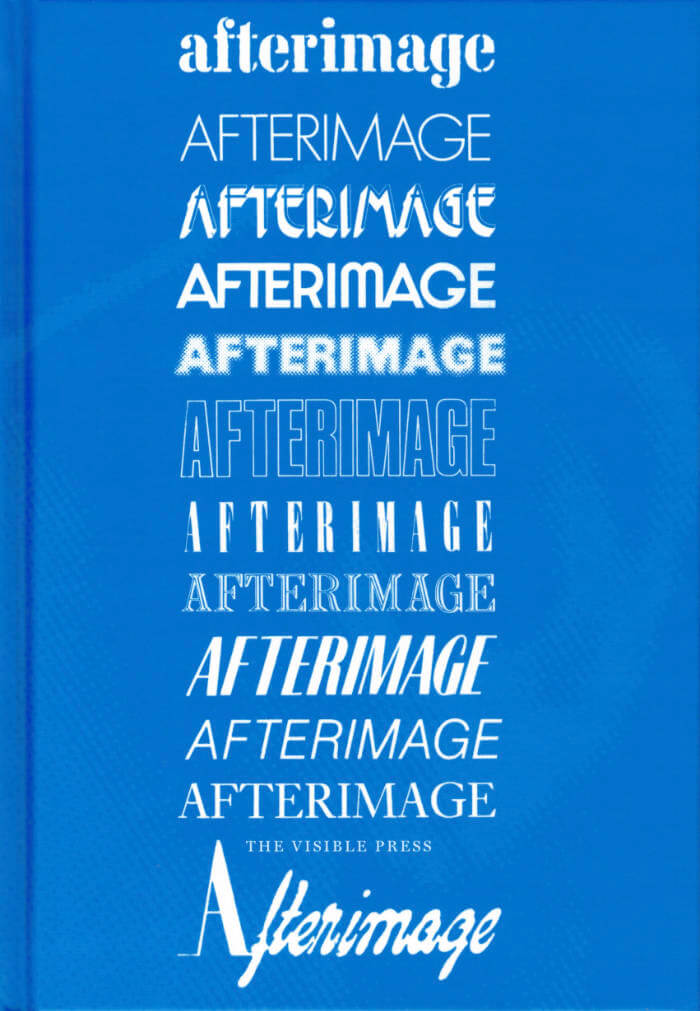
The Afterimage Reader
The independent British film journal Afterimage published thirteen issues between 1970 and 1987. International in scope, it surveyed the many forms of radical cinema during an extraordinary period of film history.
Having emerged in the wake of post-1968 cultural and political change, Afterimage charted contemporary developments with special issues on themes such as the avant-garde, Latin American cinema and visionary animation, and also looked back at early film pioneers. It published many of the leading critics of the period and vitally provided a forum for filmmakers’ writings and manifestos.
This indispensable collection includes texts by scholars Noël Burch, Roger Cardinal, B. Ruby Rich and Peter Wollen, filmmakers Jean Epstein, Jean-Luc Godard, Derek Jarman and Jan Švankmajer, plus extended interviews with Hollis Frampton and Raúl Ruiz, and more.
The Afterimage Reader is edited by Mark Webber and features new contributions from two of the journal’s editors, Simon Field and Ian Christie.

How to Become Irrésistibles
How to become Irrésistibles est une édition de l'école supérieure des beaux-arts de Bordeaux réalisée avec la maison d'édition How to Become.
Cette édition est née de l'énergie d'un groupe d'autrices étudiantes de l'école des beaux arts de Bordeaux. Elles (car il s'agit d'une majorité de femmes) se rassemblent dans les séminaires Irrésistibles – briser les cases (art-femmes-territoires) dirigés par Marie Legros, artiste et professeure. Ce séminaire a été créé par cette dernière en 2016 afin d'encourager les pratiques féministes dans l'écriture. Qu'est-ce que c'est ? Des façons autres d'écrire le genre (l'identité) et les genres (littéraires), la langue (nationale) et de faire entrer du commun dans l'écriture (en arrêtant d'en exclure les femmes, les homos, les personnes racisées, les prolos). Les étudiantes qui participent à ce séminaire, issues de nationalités différentes, s'en sont saisis pour tordre la généalogie poétique franco-française masculiniste. L'autrice et éditrice sabrina soyer (éditions How to become), invitée à prendre part aux recherches dans ce séminaire, a coordonné cet ouvrage en l'axant sur des échanges de traduction entre autrices et l'usage du français comme langue étrangère. Le livre explore – c'est à dire donne de la valeur à – différentes formes de contacts entre auteurices : traductions, réponses adressées, écriture sous influence ou fan fiction... Chaque langue et voix se tisse en écho à une autre, pas de poèmes isolés, un grand texte comme un grand corps amassé par rebonds et frottements.
Avec : Hani Yikyung Han, Nayun Eom, Charles Dauphinot, Layan Qarain, Viktoria Oresho, Samuel R. Delany, Seobin Park, Jie Liang, Rami Karim, Yu-Wen Wang, Ching-Chuan Kuo, Mélanie Blaison, Barbara Sirieix, sabrina soyer, Yan Tong Liu, Jessica Guez Karen Johanns, Marie Legros M, Esther Sauzet, Mira Mattar.

Spike #73 – Vulnerability
To live means to be exposed, to be vulnerable, and seek safety. But what if we give up control and don't try to cover the wounds any more? Could we ultimately transcend to openness? This is one of the core questions Spike asks in its autumn issue. From the imperfections of the body to automated text generators, from poor images to pop stars. Spike #73 is about art's soft underbelly, why writing in first person is a risk, why humans fear each other, and grappling with grief, paranoia, and intoxication. Let's find out what happens if we take off our shells.
With contributions by: McKenzie Wark, Marlene Dumas, Tosh Basco, James Richards, Raimundas Malašauskas, Joanna Walsh, Kandis Williams, Mire Lee, Gustav Metzger, Rob Horning, Tea Hacic-Vlahovic, Constance Debré, Luca Lo Pinto, Simone Forti...

Sint-Lucas School of Arts Antwerp
TYPP #8 — Blind Spot
The human eye is designed with a flaw that is common to all other vertebrates: we have a blind spot, the punctum caecum, a small patch on the inside of our boisterous orbs of vision with no photoreceptors. A blind spot can also be psychological or social. We tend to be biased towards situations or people we cannot fully ‘see through’. How can we enlighten our blind spots? What kind of artistic practices can inspire new readings of history, art, music, or even politics?
With contributions by Bent Vande Sompele, Pierre-Antoine Vettorello & Stella Nyanchama Okemwa, and Haseeb Ahmed. Design by Ward Heirwegh. Chief Editor: Zeynep Kubat. Editorial Board: Mekhitar Garabedian, Caroline Dumalin, Saskia Van der Gucht, Paul Hendrikse.

nY49 — trans*
Sven Van den Bossche, Hans Demeyer and 1 more
“Een thematisch nummer maken over trans*esthetiek riskeert trans*heid meteen als iets aparts te signaleren, als iets wat niet simpelweg kan zijn; hoe stel je ‘gewoon’ een special issue samen?”
Het nummer werd samengesteld door Dagmar Bosma, Hans Demeyer en Sven Van den Bossche.
Met bijdrages van: Ada M. Patterson, Camille Pier, Sven Van den Bossche, Alara Adilow, Nour Helou & Afrang Nordlöf Malekian, Mariken Heitman, misha verdonck, Dagmar Bosma, Hans Demeyer, Torrey Peters, Kato Trieu, Valentijn Hoogenkamp, Romeo Roxman Gatt, Lieks Hettinga, Kalib Batta, Kopano Maroga, Hannah Chris Lomans en Nele Buyst.

Robida magazine n. 8 — Isola Otok Island
Robida 8 is imagined and organised as a journey, that can explore aspects of island life along a narrative thread, as if developing the structure of an epic voyage: from the Embarkation – where introductory perspectives on islands are offered –, then into the Departure – which considers the islands from afar, as conceptual entities –, through the Tempest – representative of the turmoils and movement that island stand for –, passing from the Strandedness – where the island coincides with stillness –, to finally approach the Homecoming, and the island as repository of collective as well as personal memory. The aim is for this journey to enrich our understanding of islands, as fertile ground for exploring what it means to inhabit a place.
Robida is a multilingual cultural magazine. It is published yearly by the association Robida which is based in Topolò, a village of twenty inhabitants on the border between Italy and Slovenia. The magazine explores different topics – such as abandonment, silence, the relation between domesticity and wildness, forest etc. – which are connected to the place where the magazine comes to life, namely Topolò. The eight issue reflects on the island which is explored through essays, photography, art projects, academic texts, interviews and personal written by authors from all over the world, from Argentina to Poland, from US to Slovenia.
Trilingual edition: Italian / Slovenian / English
Editorial board: Dora Ciccone, Maria Moschioni, Elena Rucli, Vida Rucli, Laura Savina, Aljaž Škrlep, Janja Šušnjar.
Contributors: Adele Dipasquale and Cristina Lavosi, Adriana Gallo, Agnieszka Dragon, Ajda Bračič, Alessandro Simone and Francesca Cassi, Alice Pedroletti and Alessandra Saviotti, Ana Escariz Péres, Anna Bierler, Anne Kathrin Müller, Antônio Frederico Lasalvia, Brechje Krah, Camilla Isola, Camilla Marrese and Gabriele Chiapparini, Chiara Alexandra Young, Chiara Dorbolò, Constanze Flamme, Deborah Mora, Dora Ciccone, Elena Rucli, Federica Carlotta Lai, Gabriele Zagaglia and Fernanda Villari, Giacomo Bianco, Giampaolo De Pietro, Giuditta Trani, Greta Biondi and Vittoria Rubini, Guglielmo Giomi, Haydée Touitou, Igor Martinig, Kaja Rakušček, Katrina Pelikan Bašelj, Laura Savina, Léna Lewis-King, Livia Galtieri, Ludivine Gragy, Ludovica Battista, make LARMO, Mara-Luna Brandt Corstius, Marcos Beccari, Margherita Falqui, Marie Ilse Bourlanges, Marie Kerkeling, Marta Marini and Cecilia Bima, Marta Marini and Francesca Matracchi, Mauro Tosarelli, Melissa Carnemolla, Mercedes Villalba, Ola Korbańska, Olya Korsun, Opher Thomson, Rachele Daminelli, Romane Bourgeois, Silvia Sfiligiotti, Siria Falleroni, Stefano Conti, Tanja Marmai, Titta C. Raccagni, Tymon Hogenelst and Jesse van der Ploeg, Valerija Intihar, Vidya Narine, William Belloche.

Worms #5 'Impurity'
In this issue, Worms explores New Narrative alongside writers working today that incorporate some of it’s themes. The cover star Saidiya Hartman talks with Rhea Dillon about the limits and processes of creating stories from the archive, while Camille Roy and Dodie Bellamy give insight into New Narrative from their experiences involved in the movement. Savannah Knoop tells about their life playing the character of J.T Leroy, while Calla Henkel delves into ideas of using other people’s narratives as our own. There’s lots of gleaning, lots of stealing and lots of hard truths coming from the human body. There is poetry and fiction and all of the usual bits, as well as an experimental cut up piece demonstrating the appropriation method that Kathy Acker (via William Burroughs) used in so much of her work. Many more worms to be found in these pages.
Featuring:
Saidiya Hartman, Camille Roy, Dodie Bellamy, Lynne Tillman, Estelle Hoy, Rhea Dillon, Savannah Knoop, Lauren Fournier, Madelyne Beckles, Joanna Walsh, Anne Turyn, Cristina Morales, Calla Henkel, Jenny Zhang
Contributors:
Zara Joan Miller, Haydee Touitou, Nicole Della Costa, Cecilia Pavón, Valentina Von Klencke, Feyi Adegbite, Alice Platti, Victoria Campa, Alice Butler, Clemmie Bache, Caitlin Mcloughlin, Jack Stuart Mills, Honor Weatherall, Arcadia Molinas, Aimee Ballinger, Wes Knowler, Eleanor Wang, Katy Dadacz, Olive Couri, Rachel Cattle, Isabelle Bucklow, Sarah Bodri, Hope Roafl, Maura Sappilo, Jodie Hill, Jacqueline Ennis Cole, Mary Watt, Delia Rainey.

Press & Fold — Notes on making and doing fashion
This Press & Fold issue on Resistance presents conversations, propositions and imaginations of fashion and resistance outside of fashion’s industrial context. For protest and resistance to become effective, it depends on community to generate, support and further it: with this issue we think further on these ideas of protest, activism and resistance in and around fashion, and not only in terms of clothing, and how it is portrayed in (fashion) imagery, but also in terms of how fashion is structured and organized: is fashion only able to thrive within a capitalist structure, or are there other possibilities as well? What ideas, initiatives and structures can be developed for fashion to become inclusive and generous to all participants? What needs to be resisted and what needs to be embraced? In that sense this issue of Press & Fold, as well as the previous issues, is a world-building exercise, and wants to show what we can do without, and what we need to move fashion towards becoming a generous to all participants involved?
— Note from the publisher
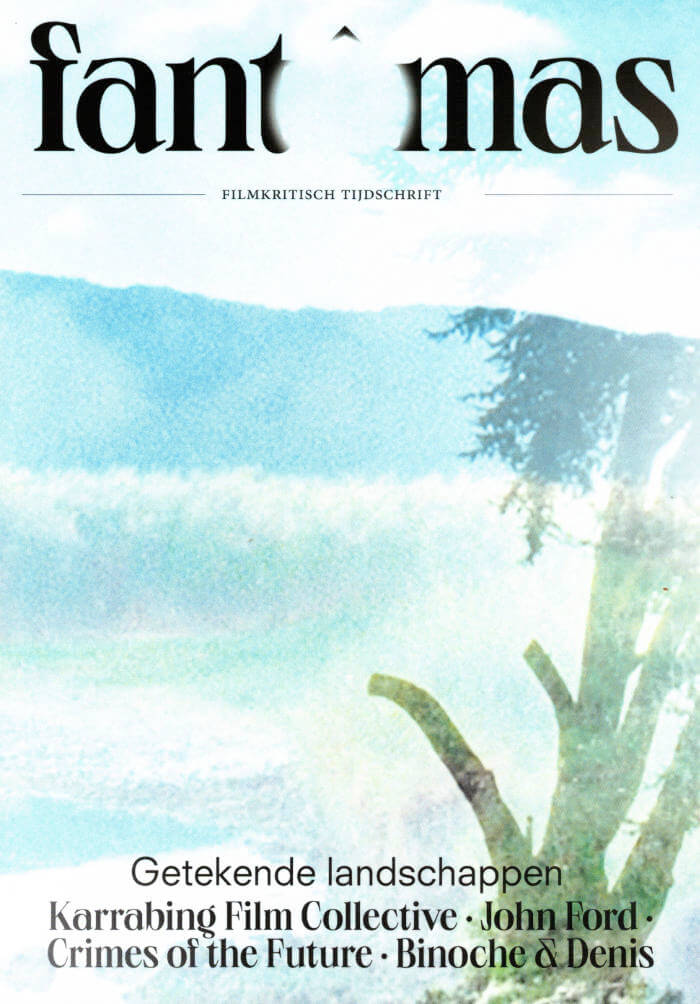
Fantomas #4 — Getekende Landschappen
Bart Versteirt, Bjorn Gabriels and 1 more
Terwijl film station per station de moderne tijd bracht, verdween schijnbaar natuur steeds meer uit ons blikveld. Tegelijk zorgt film tot op vandaag voor nieuwe manieren om natuur te portretteren. Op het kruispunt van verdwijnen en verschijnen vinden we in film en landschap compagnons de route die elkaar slechts zelden uit het oog verliezen.

Plant Magic - Poison∼Remedy
Plant Magic gathers writers, artists, poets, illustrators, plant-and-mushroom-lovers and ecological thinkers, to share their experiences, knowledges, and stories around plant and mushroom magic. Oscillating between poison and remedy, plants and mushrooms reconcile ambivalences. They are powerful agents that are unpredictable in their existence and effects. They hold potential for resistance, intelligence and knowledge beyond human understanding.
When we look at plants and mushrooms we see hope amongst ecological grief. Every day we witness this magic of growing organisms, transformation and resilience. We are looking to them for guidance while still learning to listen to their silent, sensual ways. Often, the act of listening itself can calm our buzzing minds and raging hearts and make meaning blossom in a wordless way. In this publication, you might encounter stories of creating relationships with plants and mushrooms, fungal intimacy, poetic love letters to plants, herbal spells, stories of becoming postcolonial mushrooms, tips for combating the disturbing presence of scorpions, an essay introducing you to psychedelic becoming and many visual contributions of more-than-human relations.
[Publishers' note]
Contributors: Aimilia Efthimiou, Anais-karenin, Anı Ekin Özdemir, Avant Garden, Bastian Carstensen, Carla Di Girolamo, Coline-Lou Ramonet Bonis, Corinne Wiss, Cory Papalardo, Ella Ponizovsky Bergelson, Freia Kuper, Freya Häberlein, Indra Leonard Frings, Ko-Fan Lin, Leonie Brandner, Lucie Feigl, Lucila Pacheco Dehne, Marta Orlando, Maya Land, Monaline Mourbat, Nicola van Straaten, Nina Berfelde, Rafa Cunha, Rahel Preisser, Sara Blosseville, Shani Leseman, Yasmine Ostendorf, Sigourney Pilz, Totholz 5d, Xrysafeniax